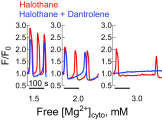Dantrolene requires Mg2+ to arrest malignant hyperthermia
- PMID: 28373535
- PMCID: PMC5422773
- DOI: 10.1073/pnas.1619835114
Dantrolene requires Mg2+ to arrest malignant hyperthermia
Abstract
Malignant hyperthermia (MH) is a clinical syndrome of skeletal muscle that presents as a hypermetabolic response to volatile anesthetic gases, where susceptible persons may develop lethally high body temperatures. Genetic predisposition mainly arises from mutations on the skeletal muscle ryanodine receptor (RyR). Dantrolene is administered to alleviate MH symptoms, but its mechanism of action and its influence on the Ca2+ transients elicited by MH triggers are unknown. Here, we show that Ca2+ release in the absence of Mg2+ is unaffected by the presence of dantrolene but that dantrolene becomes increasingly effective as cytoplasmic-free [Mg2+] (free [Mg2+]cyto) passes mM levels. Furthermore, we found in human muscle susceptible to MH that dantrolene was ineffective at reducing halothane-induced repetitive Ca2+ waves in the presence of resting levels of free [Mg2+]cyto (1 mM). However, an increase of free [Mg2+]cyto to 1.5 mM could increase the period between Ca2+ waves. These results reconcile previous contradictory reports in muscle fibers and isolated RyRs, where Mg2+ is present or absent, respectively, and define the mechanism of action of dantrolene is to increase the Mg2+ affinity of the RyR (or "stabilize" the resting state of the channel) and suggest that the accumulation of the metabolite Mg2+ from MgATP hydrolysis is required to make dantrolene administration effective in arresting an MH episode.
Keywords: dantrolene; magnesium; malignant hyperthermia; ryanodine receptor; skeletal muscle fiber.
Conflict of interest statement
The authors declare no conflict of interest.
Figures






Comment in
-
Mind the magnesium, in dantrolene suppression of malignant hyperthermia.Proc Natl Acad Sci U S A. 2017 May 2;114(18):4576-4578. doi: 10.1073/pnas.1704103114. Epub 2017 Apr 25. Proc Natl Acad Sci U S A. 2017. PMID: 28442565 Free PMC article. No abstract available.
Similar articles
-
Pharmacological distinction between dantrolene and ryanodine binding sites: evidence from normal and malignant hyperthermia-susceptible porcine skeletal muscle.Biochem J. 1997 Sep 15;326 ( Pt 3)(Pt 3):847-52. doi: 10.1042/bj3260847. Biochem J. 1997. PMID: 9307036 Free PMC article.
-
Halothane modulation of skeletal muscle ryanodine receptors: dependence on Ca2+, Mg2+, and ATP.Am J Physiol Cell Physiol. 2008 Apr;294(4):C1103-12. doi: 10.1152/ajpcell.90642.2007. Epub 2008 Feb 27. Am J Physiol Cell Physiol. 2008. PMID: 18305228 Free PMC article.
-
Molecular Aspects Implicated in Dantrolene Selectivity with Respect to Ryanodine Receptor Isoforms.Int J Mol Sci. 2023 Mar 12;24(6):5409. doi: 10.3390/ijms24065409. Int J Mol Sci. 2023. PMID: 36982484 Free PMC article.
-
Malignant hyperthermia: an inherited disorder of skeletal muscle Ca+ regulation.Biosci Rep. 2001 Apr;21(2):155-68. doi: 10.1023/a:1013644107519. Biosci Rep. 2001. PMID: 11725864 Review.
-
Dantrolene : From Malignant Hyperthermia to Alzheimer's Disease.CNS Neurol Disord Drug Targets. 2019;18(9):668-676. doi: 10.2174/1871527317666180619162649. CNS Neurol Disord Drug Targets. 2019. PMID: 29921212 Free PMC article. Review.
Cited by
-
Dantrolene corrects cellular disease features of Darier disease and may be a novel treatment.EMBO Mol Med. 2024 Sep;16(9):1986-2001. doi: 10.1038/s44321-024-00104-3. Epub 2024 Jul 26. EMBO Mol Med. 2024. PMID: 39060641 Free PMC article.
-
Structural identification of the RY12 domain of RyR1 as an ADP sensor and the target of the malignant hyperthermia therapeutic dantrolene.bioRxiv [Preprint]. 2024 Oct 24:2024.10.21.619409. doi: 10.1101/2024.10.21.619409. bioRxiv. 2024. PMID: 39484412 Free PMC article. Preprint.
-
Malignant Hyperthermia: A Case Study in the Dental Ambulatory Surgery Setting.Anesth Prog. 2019 Winter;66(4):202-210. doi: 10.2344/anpr-66-04-03. Anesth Prog. 2019. PMID: 31891296 Free PMC article.
-
Junctional membrane Ca2+ dynamics in human muscle fibers are altered by malignant hyperthermia causative RyR mutation.Proc Natl Acad Sci U S A. 2018 Aug 7;115(32):8215-8220. doi: 10.1073/pnas.1800490115. Epub 2018 Jul 23. Proc Natl Acad Sci U S A. 2018. PMID: 30038012 Free PMC article.
-
Ryanodine Receptor 1-Related Myopathies: Diagnostic and Therapeutic Approaches.Neurotherapeutics. 2018 Oct;15(4):885-899. doi: 10.1007/s13311-018-00677-1. Neurotherapeutics. 2018. PMID: 30406384 Free PMC article. Review.
References
Publication types
MeSH terms
Substances
LinkOut - more resources
Full Text Sources
Other Literature Sources
Miscellaneous

